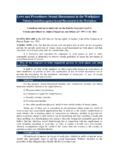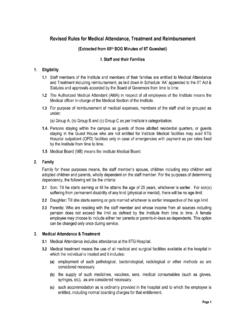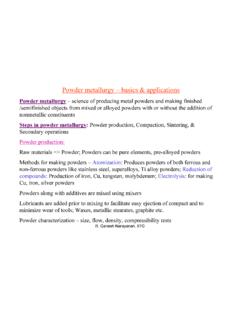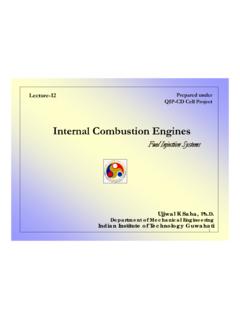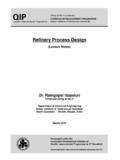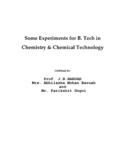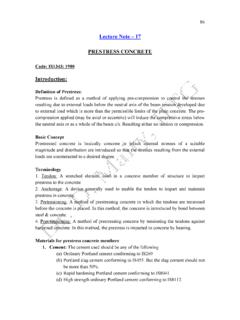Transcription of ME 101: Engineering Mechanics - IIT Guwahati
1 ME 101: Engineering MechanicsRajib Kumar BhattacharjyaDepartment of Civil EngineeringIndian Institute of Technology GuwahatiM Block : Room No 005 : Tel: : Division II &IV (3 1 0 8)2 DAYDIV IIDIV (PM) (AM) (PM) (AM) (PM) (AM)Lecture Schedule: Venue L2 (Div. II & IV)Tutorial Schedule: Thurs: 8:00-8:55 (AM)ME101: SyllabusRigid body static: Equivalent force system. Equations of equilibrium, Free body diagram, Reaction, Static indeterminacy and partial constraints, Two and three force : 2D truss, Method of joints, Method of section. Frame, Beam, types of loading and supports, Shear Force and Bending Moment diagram, relation among load-shear force-bending : Dry friction (static and kinematics), wedge friction, disk friction (thrust bearing), belt friction, square threaded screw, journal bearings (Axle friction), Wheel friction, Rolling of Gravity and Moment of Inertia: First and second moment of area and mass, radius of gyration, parallel axis theorem, product of inertia, rotation of axes and principal M.
2 I., Thin plates, by direct method (integration), composite work and Energy method: Virtual Displacement, principle of virtual work, mechanical efficiency, work of a force/couple (springs etc.), Potential Energy and equilibrium, of Particles: Rectilinear motion, curvilinear motion rectangular, normal tangential, polar, cylindrical, spherical (coordinates), relative and constrained motion, space curvilinear of Particles: Force, mass and acceleration, work and energy, impulse and momentum, of Rigid Bodies: Translation, fixed axis rotation, general planner motion, work-energy, power, potential energy, impulse -momentum and associated conservation principles, Euler equations of motion and its application.
3 UP TO MID SEMD epartment of Civil Engineering : IIT GuwahatiCourse web: principles: Equivalent force system; Equations of equilibrium; Freebody diagram; Reaction; Static : Difference between trusses, frames and beams,Assumptionsfollowed in the analysis of structures; 2D truss; Method of joints; Methodof section23 Frame; Simple beam; types of loading and supports; Shear Force andbending Moment diagram in beams; Relation among load, shearforce andbending : Dry friction; Description and applications of friction in wedges,thrust bearing (disk friction), belt, screw, journal bearing (Axle friction);Rolling work and Energy method: Virtual Displacement; Principle of virtualwork; Applications of virtual work principle to machines; Mechanicalefficiency; Work of a force/couple (springs etc.)
4 ;46 Potential energy and equilibrium; stability. Center of Gravity and Momentof Inertia: First and second moment of area; Radius of gyration;57 Parallel axis theorem; Product of inertia, Rotation of axesand principalmoment of inertia; Moment of inertia of simple and moment of : Text/Reference BooksI. H. Shames, Engineering Mechanics : Statics and dynamics, 4thEd, PHI, P. Beer and E. R. Johnston, Vector Mechanics for Engineers, Vol I - Statics, Vol II Dynamics, 9thEd, Tata McGraw Hill, L. Meriam and L. G. Kraige, Engineering Mechanics , Vol I Statics, Vol II Dynamics, 6thEd, John Wiley, C. Hibbler, Engineering Mechanics : Principles of Statics and Dynamics, Pearson Press, Ruina and Rudra Pratap, Introduction to Statics and Dynamics, Oxford University Press, 2011 Department of Civil Engineering : IIT GuwahatiMarks DistributionEnd Semester 40 Mid Semester 20 Quiz10 Tutorials15 Assignment05 Classroom Participation1075% Attendance MandatoryTutorials: Solve and submit on each ThursdayAssignments: Solve later and submit it in the next class ME101: Tutorial GroupsGroup Room of the TutorT1L1Dr.
5 Karuna KalitaT2L2Dr. Satyajit PandaT3L3Dr. Deepak SharmaT4L4Dr. M Ravi SankarT51006 Dr. Ganesh NatrajanT61G1 Dr. Sachin S GautamT71G2 Dr. Swarup BagT81207 Prof. Sudip TalukdarT92101 Dr. Arbind SinghT102102 Prof. Anjan DuttaT113202 Dr. Kaustubh DasguptaT124001 Dr. Bishnupada MandalT134G3 Prof. V. S. MoholkarT144G4 Dr. A. K. GolderTutorial sheet has three sections Section I: Discuss by the tutor (2 questions)Section II: Solve by the students inthe class (4 questions)Section II: Solve by the studentsAs assignment(4 questions)ME101: Engineering MechanicsMechanics: Oldest of the Physical SciencesArchimedes(287-212 BC): Principles of Lever and Buoyancy! Mechanics is a branch of the physical sciences that is concerned with the state of rest or motion of bodies subjected to the action of Mechanics ME101 StaticsDynamicsDeformable-Body Mechanics , and Fluid MechanicsEngineering MechanicsRigid-body Mechanics a basic requirement for the study of the Mechanics of deformable bodies and the Mechanics of fluids (advanced courses).
6 Essential for the design and analysis of many types of structural members, mechanical components, electrical devices, etc, encountered in rigid body does not deform under load! Engineering MechanicsRigid-body MechanicsStatics: deals with equilibrium of bodies under action of forces (bodies may be either at rest or move with a constant velocity). Engineering MechanicsRigid-body Mechanics Dynamics: deals with motion of bodies (accelerated motion) Mechanics : Fundamental ConceptsLength (Space): needed to locate position of a point in space, & describe size of the physical system Distances, Geometric PropertiesTime: measure of succession of events basic quantity in DynamicsMass: quantity of matter in a body measure of inertia of a body (its resistance to change in velocity)Force: represents the action of one body on another characterized by its magnitude, direction of its action, and its point of application Force is a Vector.
7 Fundamental ConceptsNewtonian MechanicsLength, Time, and Mass are absolute conceptsindependent of each otherForce is a derived conceptnot independent of the other fundamental concepts. Force acting on a body is related to the mass of the body and the variation of its velocity with can also occur between bodies that are physically separated (Ex: gravitational, electrical, and magnetic forces) Mechanics : Fundamental ConceptsRemember: Mass is a property of matter that does not change from one location to another. Weight refers to the gravitational attraction of the earth on a body or quantity of mass. Its magnitude depends upon the elevation at which the mass is located Weight of a body is the gravitational force acting on : IdealizationsTo simplify application of the theoryParticle: A body with mass but with dimensions that can be neglectedSize of earth is insignificant compared to the size of its orbit.
8 Earth can be modeled as a particle when studying its orbital motionMechanics: IdealizationsRigid Body: A combination of large number of particles in which all particles remain at a fixed distance (practically) from one another before and after applying a properties of a rigid body are not required to be considered when analyzing the forces acting on the most cases, actual deformations occurring in structures, machines, mechanisms, etc. are relatively small, and rigid body assumption is suitable for analysisMechanics: IdealizationsConcentrated Force: Effect of a loading which is assumed to act at a point (CG) on a body. Provided the area over which the load is applied is very small compared to the overall size of the : Contact Force between a wheel and kN160 kNMechanics: Newton s Three Laws of MotionFirst Law: A particle originally at rest, or moving in a straight line with constant velocity, tends to remain in this state provided the particle is not subjected to an unbalanced law contains the principle of the equilibrium of forces main topic of concern in StaticsBasis of formulation of rigid body : Newton s Three Laws of MotionSecond Law.
9 A particle of mass m acted upon by an unbalanced force F experiences an acceleration a that has the same direction as the force and a magnitude that is directly proportional to the = mamSecond Law forms the basis for most of the analysis in DynamicsMechanics: Newton s Three Laws of MotionThird law is basic to our understanding of Force Forces always occur in pairs of equal and opposite Law: The mutual forces of action and reaction between two particles are equal, opposite, and : Newton s Law of Gravitational AttractionF= mutual force of attraction between two particlesG= universal constant of gravitation Experiments G= ( )Rotation of Earth is not taken into accountm1, m2= masses of two particlesr= distance between two particles221rmmGF=Weight of a body (gravitational force acting on a body) is required to be computed in Statics as well as Dynamics.
10 This law governs the gravitational attraction between any two Attraction of the Earth2rmMGWe=mgW=Weight of a Body: If a particle is located at or near the surface of the earth, the only significant gravitational force is that between the earth and the particleLet g= G Me/r2= acceleration due to gravity ( )Assuming earth to be a non-rotating sphere of constant density and having mass m2= MeWeight of a particle having mass m1= m:r= distance between the earth s center and the particleMechanics: UnitsmgW=maF=Four Fundamental Quantities N = N = Newton is the force required to give a mass of 1 kg an acceleration of 1 m/s2 QuantityDimensional SymbolSI UNITUnitSymbolMassMKilogramKgLengthLMete rMTimeTSecondsForceFNewtonNBasic UnitMechanics: Units PrefixesScalars and VectorsSpeed is the magnitude of : only magnitude is : time, volume, density, speed, energy, massVectors: possess direction as well as magnitude, and must obey the parallelogram law of addition (and the triangle law).
